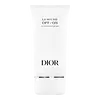What's inside
What's inside
 Key Ingredients
Key Ingredients

 Benefits
Benefits

 Concerns
Concerns

 Ingredients Side-by-side
Ingredients Side-by-side

Water
Skin ConditioningGlycerin
HumectantLauric Acid
CleansingStearic Acid
CleansingSodium Methyl Cocoyl Taurate
CleansingMaltooligosyl Glucoside
Skin ConditioningPalmitic Acid
EmollientSodium Hydroxide
BufferingHydrogenated Starch Hydrolysate
HumectantParfum
MaskingGlyceryl Stearate
EmollientPEG-100 Stearate
Pentaerythrityl Tetrabehenate
EmollientNymphaea Alba Root Extract
Skin ConditioningDipotassium Glycyrrhizate
HumectantCoco-Betaine
CleansingPotassium Hydroxide
BufferingChlorphenesin
AntimicrobialSodium Cocoyl Isethionate
CleansingSodium Benzoate
MaskingPotassium Sorbate
PreservativeTocopherol
AntioxidantCitric Acid
BufferingCaprylyl Glycol
EmollientPolyquaternium-22
Water, Glycerin, Lauric Acid, Stearic Acid, Sodium Methyl Cocoyl Taurate, Maltooligosyl Glucoside, Palmitic Acid, Sodium Hydroxide, Hydrogenated Starch Hydrolysate, Parfum, Glyceryl Stearate, PEG-100 Stearate, Pentaerythrityl Tetrabehenate, Nymphaea Alba Root Extract, Dipotassium Glycyrrhizate, Coco-Betaine, Potassium Hydroxide, Chlorphenesin, Sodium Cocoyl Isethionate, Sodium Benzoate, Potassium Sorbate, Tocopherol, Citric Acid, Caprylyl Glycol, Polyquaternium-22
Hordeum Vulgare Leaf Juice
EmollientCetearyl Alcohol
EmollientCetearyl Olivate
Propanediol
SolventHelianthus Annuus Seed Oil
EmollientPrunus Armeniaca Seed Powder
AbrasiveCitrus Limon Fruit Oil
AstringentSorbitan Olivate
EmulsifyingLactobacillus/Punica Granatum Fruit Ferment Extract
Skin ConditioningSalix Alba Bark Extract
AstringentSambucus Nigra Fruit Extract
AstringentArnica Montana Extract
Skin ConditioningBorago Officinalis Leaf Extract
Skin ConditioningCalendula Officinalis Flower Extract
MaskingMedicago Sativa Extract
TonicSpiraea Ulmaria Extract
AstringentOlea Europaea Fruit Oil
MaskingTocopherol
AntioxidantCoco-Glucoside
CleansingCetearyl Glucoside
EmulsifyingCaprylyl Glycol
EmollientKaolin
AbrasiveSclerotium Gum
Emulsion StabilisingCitrus Aurantium Peel Oil
Cetyl Palmitate
EmollientMagnolia Officinalis Bark Extract
AntimicrobialSorbitan Palmitate
EmulsifyingGlyceryl Caprylate
EmollientWater
Skin ConditioningSodium Phytate
CI 77491
Cosmetic ColorantAlcohol
AntimicrobialLimonene
PerfumingCitral
PerfumingLinalool
PerfumingHordeum Vulgare Leaf Juice, Cetearyl Alcohol, Cetearyl Olivate, Propanediol, Helianthus Annuus Seed Oil, Prunus Armeniaca Seed Powder, Citrus Limon Fruit Oil, Sorbitan Olivate, Lactobacillus/Punica Granatum Fruit Ferment Extract, Salix Alba Bark Extract, Sambucus Nigra Fruit Extract, Arnica Montana Extract, Borago Officinalis Leaf Extract, Calendula Officinalis Flower Extract, Medicago Sativa Extract, Spiraea Ulmaria Extract, Olea Europaea Fruit Oil, Tocopherol, Coco-Glucoside, Cetearyl Glucoside, Caprylyl Glycol, Kaolin, Sclerotium Gum, Citrus Aurantium Peel Oil, Cetyl Palmitate, Magnolia Officinalis Bark Extract, Sorbitan Palmitate, Glyceryl Caprylate, Water, Sodium Phytate, CI 77491, Alcohol, Limonene, Citral, Linalool
 Reviews
Reviews

Ingredients Explained
These ingredients are found in both products.
Ingredients higher up in an ingredient list are typically present in a larger amount.
Caprylyl Glycol is a humectant and emollient, meaning it attracts and preserves moisture.
It is a common ingredient in many products, especially those designed to hydrate skin. The primary benefits are retaining moisture, skin softening, and promoting a healthy skin barrier.
Though Caprylyl Glycol is an alcohol derived from fatty acids, it is not the kind that can dry out skin.
This ingredient is also used as a preservative to extend the life of products. It has slight antimicrobial properties.
Learn more about Caprylyl GlycolTocopherol (also known as Vitamin E) is a common antioxidant used to help protect the skin from free-radicals and strengthen the skin barrier. It's also fat soluble - this means our skin is great at absorbing it.
Vitamin E also helps keep your natural skin lipids healthy. Your lipid skin barrier naturally consists of lipids, ceramides, and fatty acids. Vitamin E offers extra protection for your skin’s lipid barrier, keeping your skin healthy and nourished.
Another benefit is a bit of UV protection. Vitamin E helps reduce the damage caused by UVB rays. (It should not replace your sunscreen). Combining it with Vitamin C can decrease sunburned cells and hyperpigmentation after UV exposure.
You might have noticed Vitamin E + C often paired together. This is because it is great at stabilizing Vitamin C. Using the two together helps increase the effectiveness of both ingredients.
There are often claims that Vitamin E can reduce/prevent scarring, but these claims haven't been confirmed by scientific research.
Learn more about TocopherolWater. It's the most common cosmetic ingredient of all. You'll usually see it at the top of ingredient lists, meaning that it makes up the largest part of the product.
So why is it so popular? Water most often acts as a solvent - this means that it helps dissolve other ingredients into the formulation.
You'll also recognize water as that liquid we all need to stay alive. If you see this, drink a glass of water. Stay hydrated!
Learn more about Water